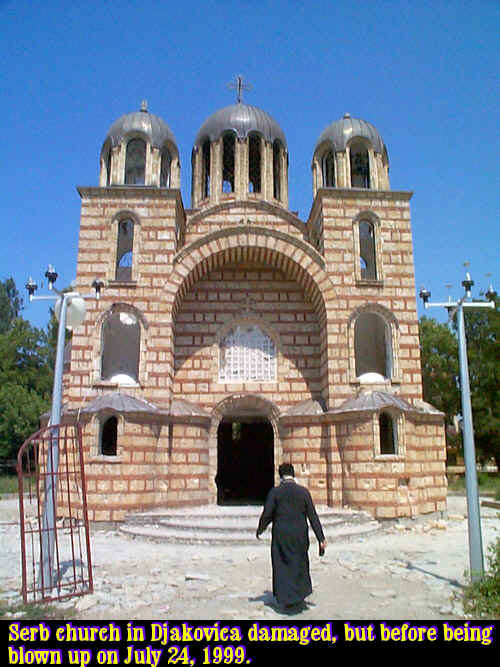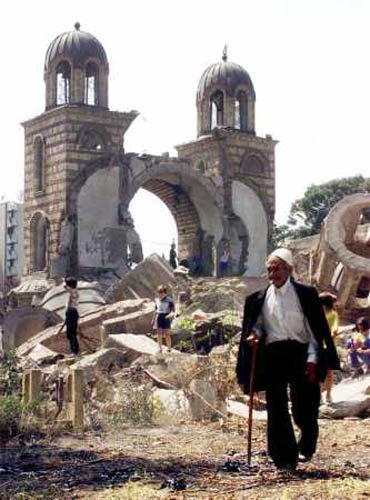1. The Medieval Holy Trinity Monastery
(the church was frescoed) near Musutiste (Suva Reka), 14th century, plundered, set on fire
and completely destroyed by explosive.
2. The Medieval church of Dormition of the Mother of God, (painted in frescoes), built in
1315, in Musutiste, burned and afterwards torn down.
3. The Medieval St. Mark's Monastery, near Korisa, Prizren, built in 1467, looted, set on
flames and totally destroyed by explosive.
4. The Medieval Monastery of St. Archangel Gabriel (with frescoes) in Binac village, near
Vitina, 14th century, looted and burned.
5. The Medieval Monastery of St. Joannicius of Devic (painted in frescoes), near Srbica,
15th century, demolished and robbed.
6. The Monastery of Dormition - St. Uros (14th century, reconstructed in 1996), Gornja
Nerodimlja, blown up with a mine and torn down.
7. The Monastery of St. Archangel (14th century, frescoed, reconstructed in 17th century),
Gornja Nerodimlja, set on fire and blown up with a mine, the graveyard has been destroyed,
the pine dating from 14th century has been cut down and burned.
8. St. Nicola's church (old church, reconstructed in 1983), Donje Nerodimlje, demolished,
set on fire, and blown up with a mine.
9. St. Stephen's church (14th century, reconstructed in 1996), Donje Nerodimlje, situated
at the graveyard, demolished, set on flames and blown up with a mine.
10. The Presentation of the Virgin church in Dolac, near Klina, built in 1620, (with
frescoes), burned, the Holy Throne demolished, afterwards mined and torn down by
explosive.
11. St. Nicola s church in Slovinje village near Lipljan, founded in 16th century,
reconstructed in 19th century, utterly destroyed by explosive.
12. St. Apostles Peter and Paul's church in Suva Reka, dating from 1938, demolished and
afterwards razed by explosive.
13. The Holy Trinity church in Petric village, near Pec (from 1993), destroyed by
explosive.
14. The Presentation of the Virgin church in Belo Polje (near Pec), from 16th century,
reconstructed in 19th century, demolished and set on flames.
15. The Cathedral of St. Uros in Urosevac, built in 1933, demolished, its interior set on
fire.
16. The church of St. Elijah the Prophet, in Vucitrn, built in 1834, plundered, demolished
and partly burned.
17. The church of St. John the Baptist, Samodreza, near Vucitrn, old church -
reconstructed in 1932, demolished, burned and torn down.
18. St Parasceva s (St. Nicola s) church in Drsnik near Pec (frescoed), dating from 16th
century, ruined, its interior set on flames.
19. The church of the Most Holy Mother of God in Naklo village, near Pec, from 1985,
destroyed and burned.
20. The Holy Trinity church in Velika Reka village, near Vucitrn, dating from 1997,
demolished, set on fire and nearly destroyed.
21. The Holy Apostles church in Petrovce village, near Kosovska Kamenica, demolished and
set on flames.
22. The church of the Most Holy Mother of God in Podgorce village, near Vitina, demolished
and burned.
23. The church of St. John the Baptist, in Pecka Banja, near Pec, from 1996, demolished,
its interior set on fire.24. The
church of the Most Holy Mother of God in Djurakovac, near Pec, built in 1997, demolished.
25. The Cathedral of the Holy Trinity, in Djakovica, built in 1998, vandalized, its
interior set on fire, a priceless mosaic over the entrance destroyed, completely razed by
explosive (July 24-25, 1999).
26. St. Nicola s church in Osojane village, near Pec, demolished.
27. The church of St. Elijah the Prophet in Bistrazin, between Prizren and Djakovica,
reconstructed on the old foundations before 1941, during the World War II ruined by the
Albanians, afterwards reconstructed for the second time in 1988, now completely
demolished.
28. St. Demetrius church in Siga, near Pec, reconstructed in 1937 on the medieval
foundations, completely razed.
29. St. Elijah s church in Zegra village, near Gnjilane, from 1931, demolished and then
completely burned down (the roof collapsed), also, two church buildings were set on
flames, and crosses and tombs in the graveyard were destroyed.
30. The church of the Holy Unmercenaries (old, reconstructed in 1991), Novake - Prizren,
demolished and set on fire, its mining was unsuccessful, the tombs around the church were
ruined.
31. The parish church in Krusevo, near Pec (old, reconstructed), broken into and partially
burned.
32. The Monastery of Sts. Cosma and Damian, the Unmercenary Healers, in Zociste (with
frescoes), from 14th century, looted and demolished, the greatest part of the residential
building was burned.
33. The parish church of St. John, in Grmovo, near Vitina, first set on fire, then
completely destroyed by explosive (July 25, 1999).
34. St. Nicola s church in Kijevo, near Klina, built in 14th century (painted in
frescoes), levelled to the ground, crosses and tombs in the graveyard ruined.
35. The church of St. Mark, the Evangelist, (on the foundations of the old church of
Presentation of the Virgin) in Klina - Metohia, destroyed by explosive.
36. St. Nicola s church in Ljubizda, near Prizren, from 16th century, plundered and
demolished; the parish centre was set on flames.
37. In the same village, Ljubizda, the church of St. Elijah, the Prophet (16th - 17th
century), situated at the graveyard, reconstructed on the old foundations, looted,
demolished, its interior set on fire, mined, the graveyard around it destroyed.
38. St. Petka s church, in Dobrcane village, between Gnjilane and Kamenica, burned, the
roof collapsed.
39. The Cathedral of Christ the Saviour in Pristina (a new one), first it had been tried
to set it on fire, and later, on August 1, 1999, at 01:00, the explosive was placed at
four sites: two mines exploded, and the other two did not.
40. St. Elijah s church (new, 1994), - Smac village, near Prizren, set on flames,
demolished, its interior mined, but not all explosive packages exploded.
41. The church of St. Basil the Great (19th century), - Gornja Srbica, near Prizren,
burned and torn down.
42. St. Petka s church (recently built), Zaskok village, near Urosevac, blown up with a
mine, torn down.
43. St. Nicola s church (old, reconstructed in 1985), Gatnje village, near Urosevac,
demolished and blown up by explosive.
44. The church of the Most Holy Mother of God (old, reconstructed), Gornje Nerodimlje,
demolished and torn down.
45. St. Elijah s church (the old, broadened in the reconstruction), in Nekodim village,
near Urosevac, demolished and set on flames.
46. The church of the St. Apostles Peter and Paul, in Talinovac, near Urosevac (recently
built), vandalized, its interior set on fire, the graveyard around it destroyed.
47. The Holy Trinity church, in Babljak village, near Urosevac, demolished, its interior
set on fire.
48. The church of the Nativity of the Mother of God, Softovic village, near Urosevac,
demolished and burned.
49. The parish church in Novi Kacanik - destiny unknown.
50. The church of the Protection of the Most Holy Mother of God (old, reconstructed), in
Korisa village, near Prizren, razed to the ground, as well as the old site of the church,
the graveyard destroyed.
|
 Back to:
Back to:

